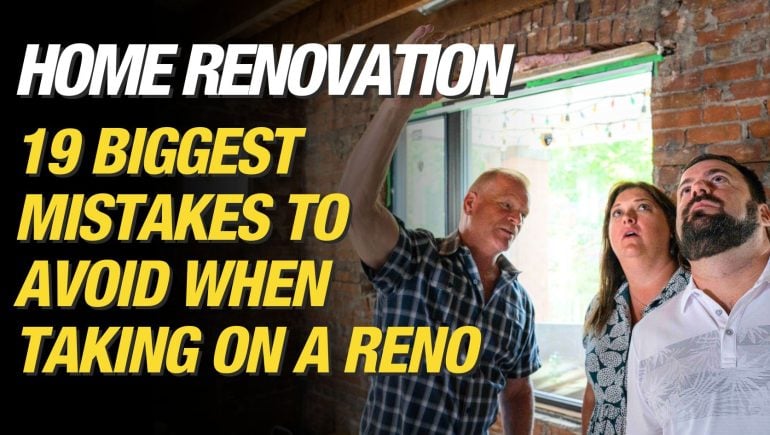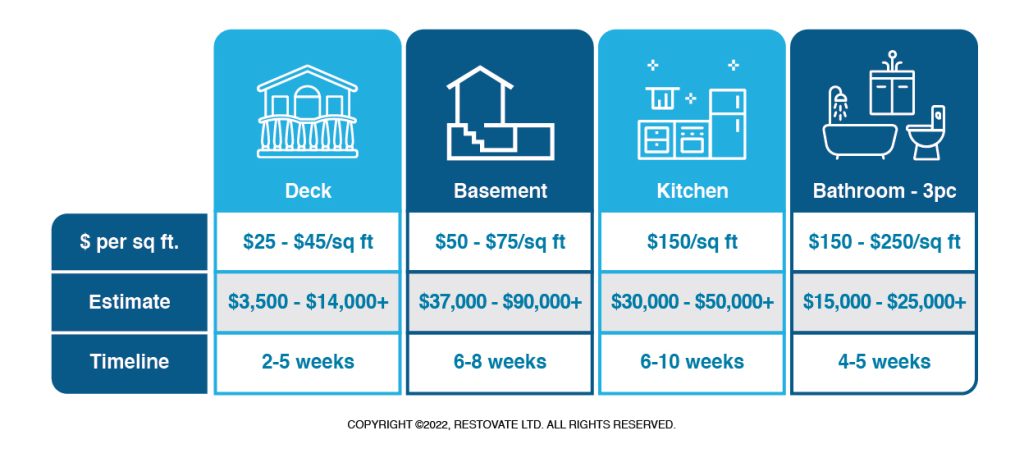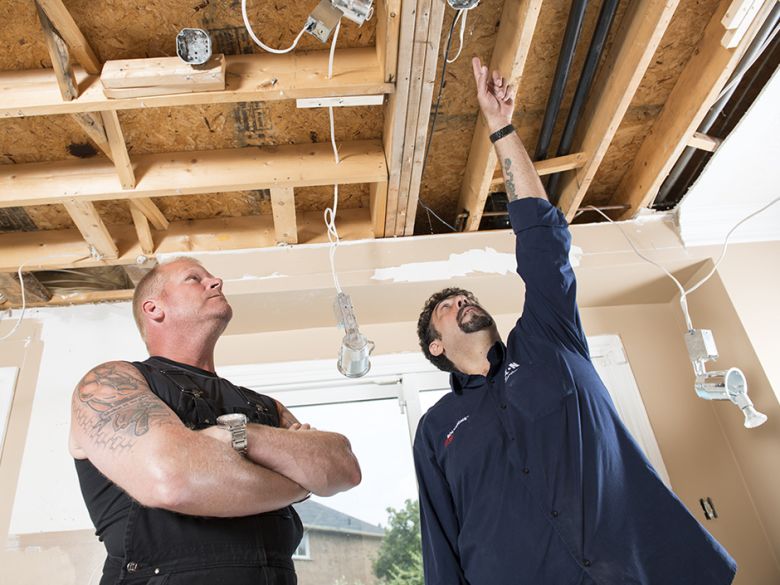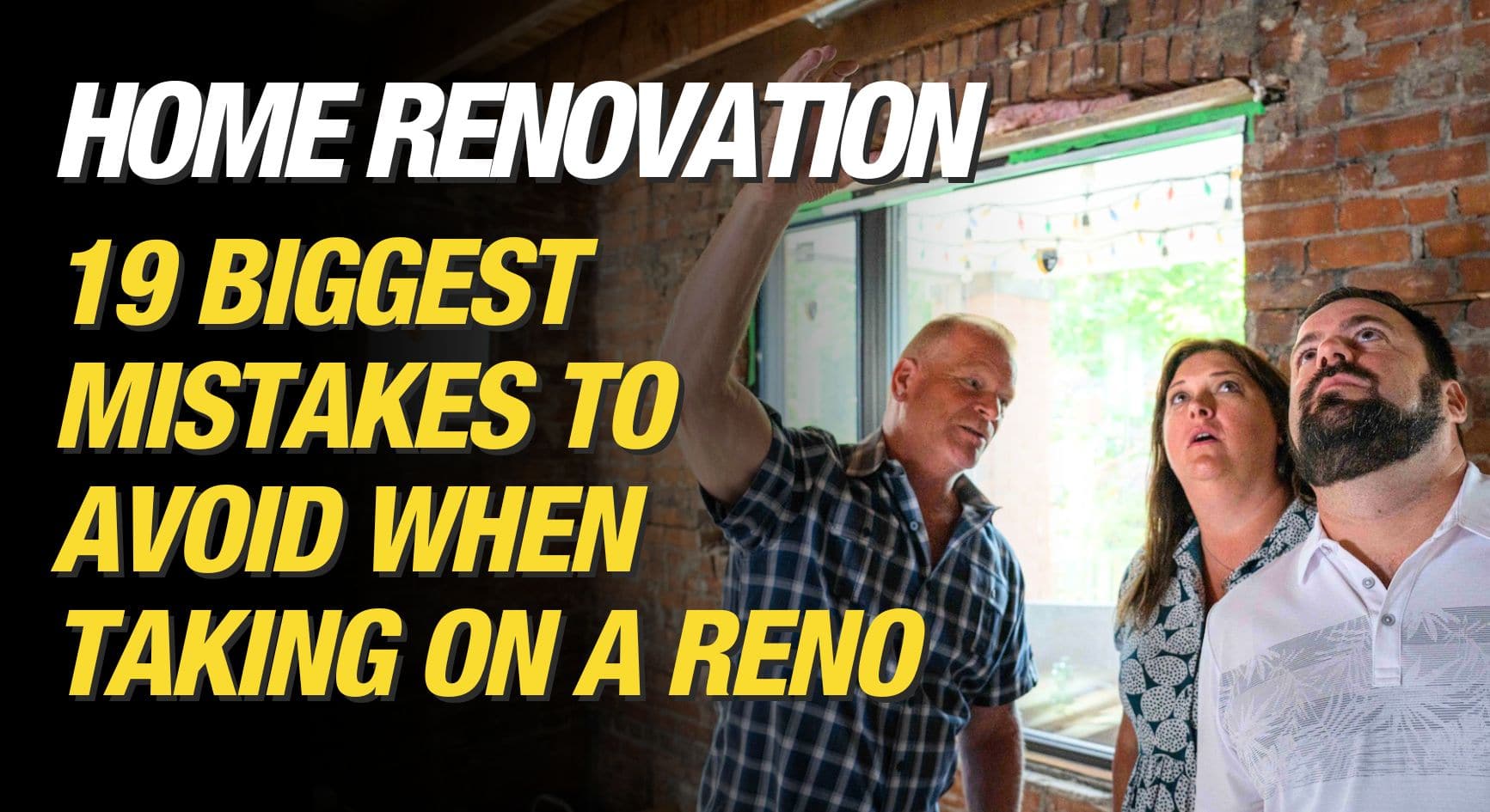Sherry Holmes Transforming a 70-Year-Old Cottage Nestled on the charming shores of Saugeen Beach, Ontario, lies a quaint 70-year-old cottage in dire need of a makeover. Sherry Holmes, renowned for...

19 Biggest Home Renovation Mistakes to Avoid
By Mike Holmes
Mike’s Advice / Design & Renovation Inspiration
Thursday, May 16th, 2024 @ 2:49pm
Mistakes to Watch Out for in Your Home Improvement Project
Let’s face it, renovations are hard, stressful, time-consuming, and expensive but they don’t have to be. No matter what, taking your time, having a realistic budget and understanding what you really want is essential. Here are the top home renovation mistakes to watch out for in your home improvement project. Use this list and your next renovation project should run smoothly.
Mistake #1: Going with the Cheapest Quote
When you interview a bunch of contractors for quotes, you may wind up with some pretty different estimates. One might be pretty high, while another is quite low – with most of them likely falling in a similar mid-range.
A thrifty homeowner might look at that low quote and think they’ve struck the jackpot – but all is not what it may seem. The contractor may have left something off your quote that’s making it much lower than the rest. It could also be that they’re quoting you with lower quality materials, less experienced sub-trades, or leaving out the cost of permits or debris removal.
Unfortunately, in some cases, the contractor may intentionally be lowballing you. You hate to hear about it, but it happens.

Basic payment schedule when working with a contractor.
Beware of contractors who offer a discount if you pay them in cash or won’t provide a receipt, this is a common practice of fraudulent contractors. Remember, cash is not traceable. Right from the start, this is a sign of a bad contractor.
Ultimately, if a quote is low, there’s probably a good reason for that. I’d be worried about the quality of the work. If you think it’s expensive to hire a pro, think about how much it’ll cost to hire a pro to fix amateur work that you tried to save a buck on.
I’m not saying you have to choose the highest quote to ensure quality work, I just want you to take a closer look at a quote that’s quite a bit lower. If it seems too good to be true, it likely is.
When you’re looking at a low quote ask if the contractor has specified all materials by brand, model, and finish. Then ask if all the work included in the project is covered line-by-line in the quote. This is why you want to see long, detailed quotes. Short and skimpy ones just won’t cover the scope of the project.
And finally, read the fine print at the bottom of the estimate and if you don’t understand it – ASK!
Mistake #2: Focusing on Finish over Structure
I get the appeal of a bright new kitchen or bathroom, believe me, I do. However, here’s what gives me pause: when I hear of homeowners rushing to address aesthetic problems with their homes over structural ones.
The first thing we do when taking on a new project is always do a home inspection so we know exactly what we are getting into. I highly recommend homeowners get a home inspection before they renovate. You should know the condition of your house so you know where to spend your money.
I also always tell homeowners to address issues with their home’s structure first. So roof, foundation, windows, doors, that sort of thing. Once that’s complete you’re ready to move on to the interior of the home. However, I still see so many homeowners get caught up in the excitement of designing their new kitchen, that they don’t consider all the issues left to address.
In that kitchen, for example, is your exhaust fan powerful enough? Does it vent out of the home like it should, or does it vent into the attic space (a big no-no)? Have you addressed the water damage from the time the old dishwasher flooded?
If you don’t take care of these items first, you’re simply covering up old issues that can eventually morph into big problems. There will be plenty of time to make your kitchen dreams come true – but START by making the kitchen sound.
Mistake #3: Ignoring Permits
As a homeowner, it’s your responsibility to ensure a permit is pulled for your renovation. In your contract, it may state that your contractor will take care of that for you (and if so, make sure they do). But where I see many smart homeowners get trapped is when they let themselves be convinced that they don’t need to obtain proper permitting for their work.
In Ontario your local building authority issues building permits if you want to build something, renovate something or tear down something, or change the purpose of a building.
If you don’t, not only can you not be certain that your renovation has been done to at least minimum code – if the city finds out that you’ve started work without a permit, you could be forced to tear it all down and rebuild from scratch. And believe me, that won’t be cheap.
And don’t forget a building permit is separate from an electric permit. You need to make sure you’re filing for all the right permits for your job.
RELATED:
Why You Need A Building Permit
5 Electrical Permits Myths – Understanding Electrical Permits
Mistake #4: Not Researching The Contractor
Do your research when looking for the best-qualified professional or contractor. Don’t just rely on your friends and family’s suggestions. Referral websites are the same! Take them with a grain of salt. You are responsible if something goes wrong, so do the work yourself.
And what about obtaining three references that I keep hearing about? It is not sufficient to just get three. Three good jobs are easy to do. Because of this, you should obtain at least 10–20 references from candidates you are considering recruiting; the more, the better.
Check out their work and talk to the homeowners. Don’t limit your search to current employment, either. Examine their work from five or ten years ago. Also, find out if you can talk to their clients—find out what their experience was like—whether they were happy with the job and if they are still happy with the job.
I’m not saying that you won’t find the right one if you only do three, but I highly recommend researching more. Plus, with the contractors being so busy, it will likely take you longer to find a contractor, and your start date may very well be not what you expect. Above all, be patient.
RELATED
How To Hire A Contractor: Do A Background Check
Mistake #5: Rushing Your Reno
Any significant renovation takes time so don’t be in a rush, because you’ll be setting yourself up for disappointment! The more time you take to prepare your renovation the smoother and more efficient it will be completed. If you’re in a rush to get something done, consider a refresh instead, concentrating on small cosmetic updates and weekend projects.
Mistake #6: No Contracts Signed
Get everything in writing, even small jobs. Everything must be a line item, including specific products, materials, finishes, fixtures, labour, etc. Ask if there are any exclusions. What are the terms and conditions, and payment structure? How are disputes or delays addressed? What are the warranties? Permits? (see #3)
Don’t assume anything. If you don’t see it in the contract, ask about it.
RELATED
Mistake #7: Skipping the Prep Work
If you are doing your own remodelling, it’s important to educate yourself on what you are getting into. If you are installing new flooring, have you properly prepped the flooring? Is it dipping down in places? Perhaps you need a self-leveler or the house has settled and an I-beam needs to be replaced?
Prep work is not an exciting part of the project, but it pays off.
RELATED
A Comprehensive Flooring Guide: How to Fix Squeaky Floors
Mistake #8: Ignoring Mould
Most of us know what mould or mildew looks like. It’s typically a dark gray speckled fuzzy-looking substance that forms and spreads on damp or humid surfaces in basements, bathrooms, and kitchens. When not addressed, it can lead to serious health issues, like respiratory issues, bronchitis and fungal infections.
However, it can also lead to structural problems. Mould infestations can compromise insulation, wood beams, floors and drywall. Sometimes, you can smell it before you can see it – most people have experienced that musty smell when entering a home or damp basement.
Another sign that you may have mould is water stains or dark patches on walls and ceilings. Has there been a history of flooding? Was it addressed, and how? Get this checked out before it’s too late, either by consulting with a water mitigation specialist or getting a specialty home inspection using a moisture meter.
RELATED
Mistake #9: Ignoring Safety on Site
One day I was helping my dad gut a room. I was young, so I was just ripping things down. The floor was completely covered by garbage. My dad told me I should stop and clean it up but I was almost done, so I told him I’d clean it up later. I needed to pull down the rest of the ceiling so I grabbed a chair – not smart – and I put it over some garbage. What I didn’t know was that it was covering a hole in the floor for the heat register.
When I stood on the chair, one of the legs went through the hole and I hit the ground. The first thing my dad asked was if I was okay. The second thing was, “Does that teach you anything?” It did.
Keep the job site clean, and keep it organized.
Mistake #10: Letting Your General Contractor Do The Electrical Work
This is essential for all homeowners to know. General Contractors cannot do electrical work in residences unless they hold an electrical contractor’s license.
In Ontario, you can confirm the contractor is licensed by checking their seven-digit ESA/ECCA number is registered with ESA/ECCA. If you hire a general contractor, confirm that a licensed subcontractor will do the electrical work.
Mistake #11: Not Budgeting Properly
Do a cost analysis before you do anything. Renovations can be expensive, so you must understand everything required for your project – materials, products, labour, and demolition. The larger the job, the more money it will be – remember to have a slush fund for contingencies.

Home renovation estimated costs to help you budget for your next project.
READ MORE
Mistake #12: Making Major Changes After Work Has Started
When you, as the homeowner, decide to make a change to the already confirmed renovation plan, this can and likely will have an impact on the overall project. In the construction world, this is known as a “change order”.
A construction change order is an excellent tool for documenting and managing change requests from clients on the project. Some change requests are optional, like when a homeowner decides they want to make the master bedroom larger. But others, like discovering the roof is leaking, are not. Changes typically impact the budget and timeline.
A change order helps you document precisely what needs to be done, what it will cost, how long it will take, and who is responsible for payment. Approved change orders become part of the original residential construction contract.
Mistake #13: Not Considering The Age Of Your Home
I find when people purchase a “newly renovated” older home they get wowed by the shiny and new factor. What I have learned is that shiny and new can often mean a coverup. I’m not saying that this is always the case but I am suggesting this is the time that you start asking the serious questions. When was the renovation completed? Was it just cosmetic? Were the proper permits pulled?
Houses built before 1940 likely have knob-and-tube so this is a flag to get the electrical inspected by a Licensed Electrical Contractor (LEC). Has there been modifications and were electrical permits pulled? If the electrical panel looks a bit like spaghetti then I’d look into the permit history and get an LEC to check out the system.
Mike Holmes and Frank (Licensed Electrical Contractor) doing a walkthrough of the house and checking the electrical work

You also want to be sure that the electrical can handle today’s electrical demands.
You also want to be sure that the electrical can handle today’s electrical load and demands. Electrical upgrades can cost $20K or more depending on the home’s size and condition. New homes built now must have at least 100 amp service but many will have 200 amp.
Also, any home built before 1980 will likely have asbestos and lead paint. There is an 87 percent likelihood that a home built before 1940 contains lead paint. Prior to the 1980s, asbestos was a common ingredient in many building supplies. Anytime you renovate an older property, you will likely run into asbestos, which when disturbed will require professional remediation.
Mistake #14: Not Considering Energy-Efficient Options
Incorporating energy-efficient features into your project, such as improved insulation, energy-efficient appliances like tankless water heaters, EV chargers, and eco-friendly building practices, will reduce your carbon footprint and lower energy costs.
RELATED:
How to Choose the Right Tankless Water Heater for Your Home
Gas Tankless Water Heaters | What You Should Know
Mistake # 15 Inappropriate Planning
I always say it takes longer to plan a renovation than to do it! Ensure you and your contractor are communicating clearly, plan ahead and are aware of ALL your requests. The more time you spend making decisions prior to the demo, the less time you’ll need for labour, which helps keep costs and timelines under control.
Also ask your contractor if his team will be working solely on your project or are they doing a couple at a time, as this will affect your finish date. Also, ensure all your materials and finishes are on schedule and there are no delays —again will affect your timelines.
And lastly, do not have unrealistic expectations. Understand and expect that projects will go over time. You never know what to expect during a renovation so always plan for things to not always go according to plan, especially when you are doing an older home.
Mistake #16 Choosing Poor Quality Material
Don’t cheap out on essentials, like high-quality building materials. I’m not saying you have to go overboard, just use your money wisely on construction materials, like mould and mildew-resistant drywall, waterproofing membranes and substructures, like the products from Schluter Systems.

We use the entire Schluter Systems in all our jobs.
Also, keep in mind maintenance and durability on items like tiles, countertops and flooring.
RELATED
Mistake #17 Lack of Effective Communication
I find that lack of communication is typically where much of the breakdown occurs in the homeowner-contractor relationship. It’s important that you establish this at the beginning of the relationship – also discuss what will be the best way of communicating. Will it be via phone calls, texts, emails or a combination of the three? If you prefer phone communication I suggest you keep a journal and also follow up with an email or text.
It’s best to document things as renovations can be complex with a lot of moving parts. Best to be organized. Also, will you have daily conversations, or weekly? Of course, this will depend on the scope and length of the job. I suggest regular communication with your main contact person (do not have several contacts). This allows for you to hear about the progress, the schedule over the coming days and to ask your questions or voice any concerns you may have.
Mistake #18 Ignoring the Future Resale Value
There are many opinions on what renovations you should do for the future resale of your home. Hot ticket areas are kitchen and bathroom improvements. Other less invasive improvements are lighting, energy efficiency upgrades and curb appeal.
Ultimately, you need to work within your budget and get the most out of your renovation budget. There’s no point in going broke doing a renovation when you won’t see a decent return. Be smart about your choices.
READ MORE
Mistake #19 Underestimating The Timeline
A common error made by homeowners is to underestimate the amount of time needed to complete a home improvement job. Building projects of all sorts, whether you’re planning a small update or a major remodel, frequently take longer than expected. So, it is always good to add some extra time to your estimate.
Also, keep in mind that products and supplies can be delayed and the unexpected surprise behind the wall will put a wrench in your timeline so be prepared.
There are many things to consider when doing any kind of renovation – big or small. The essential thing is to have a clear idea of what you want, a realistic budget, the right plan and the right team. Refer to this list when you start planning your next renovation and it should go much smoother. Good luck and happy renovating!
READ MORE
Your Home Renovation Team – Who to Hire and When?
A Holmes Guide To Prioritizing Home Renovations
Ready to Design Your Dream Home? 2024 Top Renovation and Design Trends To Consider








